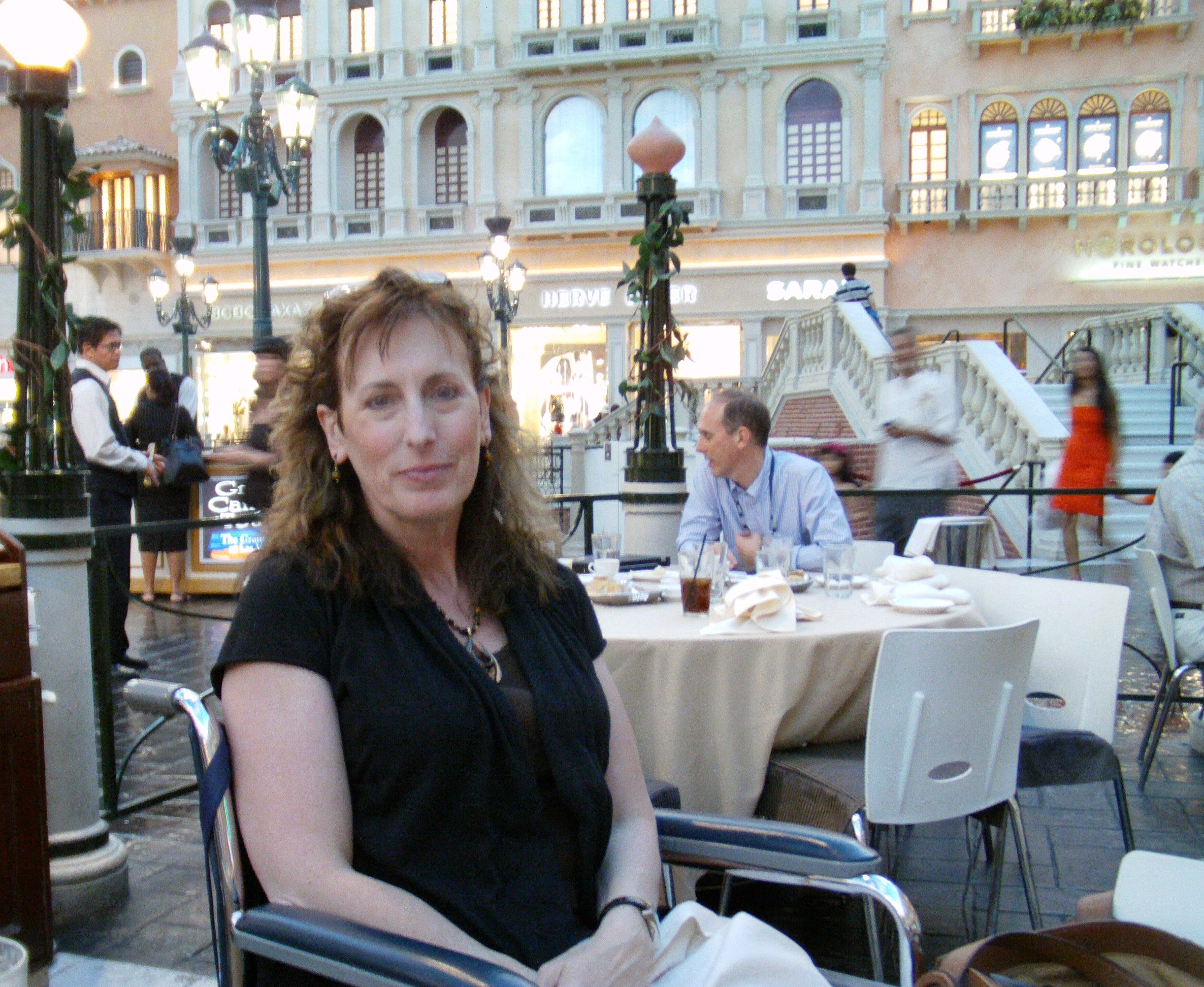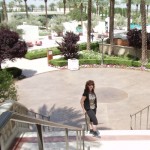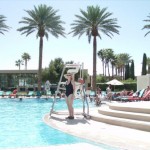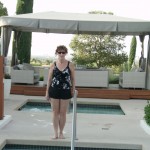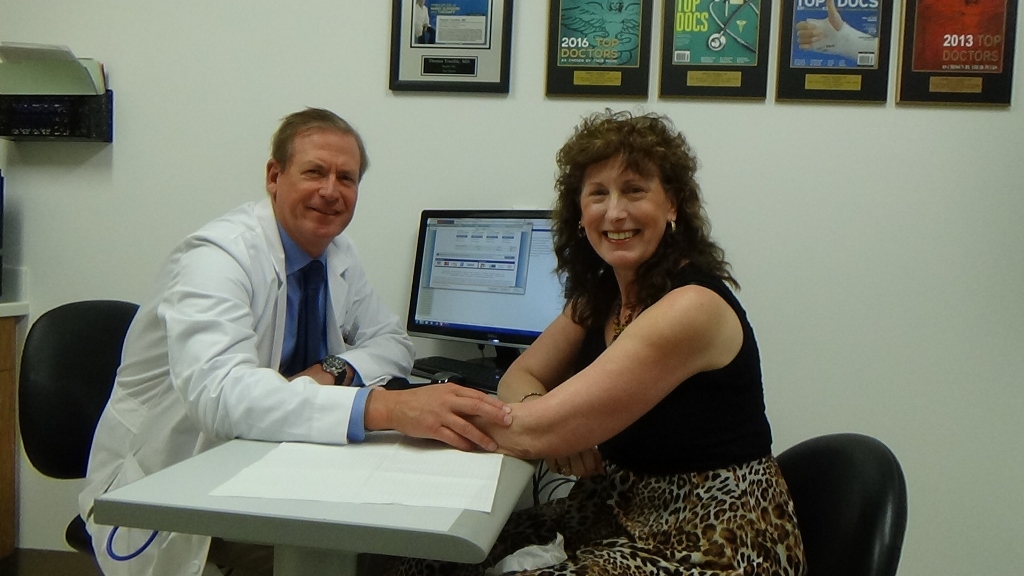The background to my Peripheral Nerve Surgery story is also indirectly connected with my Malalignment Story and my SI-Instability/Surgery Story starting over 10 years ago. All the motor function of my nerves returned in my lower left leg after the micro-discectomy surgery in April 2002. However, during the last 10 years, I had sensory nerves issues in some degree or another that seemed to get more steady in the later few years. My nerve surgeries occurred prior to the SI surgery because my lower leg pain was speaking the loudest. When I healed from the nerve surgeries, I was then keenly aware of more SI-Instability and buttock pain. For me and I assume for others, the body has a way of prioritizing pain with the worst pain at the moment catching the attention of your mind. Well the lower leg nerve pain was speaking the loudest and it wasn’t till after the first of the two nerve surgeries that I found my help for the SI-Instability/Malalignment Syndrome and finding out that these diagnosis also had a contributing factor in my nerve issues. See attached PDF Medical-Malalignment to read on pages 6-8 pertaining to peripheral nerve involvement under section titled “Asymmetry of Lower Extremity Orientation”
I had a prior NCV (Nerve Conduction Velocity Test) in April 2011 see my Chronological page for those results. Then finally here is a second EMG study:
January 9th, 2012 – EMG(Electromyogram) study on left leg
Electrodiagnostic Findings: Needle electromyography of the Left Lumbar paraspinal and lower extremity muscles revealed normal insertional activity, no denervation potentials and motor units that appeared with normal amplitude and configuration on voluntary recruitment which was in a normal pattern with full interference. Left peroneal motor disal latency, conduction velocities below and across the fibular head, and amplitudes normal. Left superficial peroneal distal latency normal with diminished amplitude. Diagnostic Impression: This is an essentially normal study without evidence of Left lumbar radiculopathy or peroneal nerve entrapment at the fibular head; the diminished superficial peroneal sensory amplitude is of doubtful clinical significance, possibly related to local injury.I thought that I didn’t have a nerve problem according to the above report or at least I knew for sure that the nerve issues were not directly related to my prior Lumbar disc degeneration. That was a great relief to know it wasn’t coming from my back but a possibility the nerve issues were localized in the lower left leg only.
I asked the following question on the website http://www.justanswer.com/ “What does left superficial peroneal sensory distal latency normal with diminished amplitude mean on my EMG report?” Here is the answer a neurologist on that website gave me: “It suggests that the axon (the nerve) is not as healthy as it could be but the impulses travel well if “conduction velocity” is fine. Some nerve fibers could have been damaged because of the injury (foot drop — peroneal nerve when abnormal, it causes foot drop).” I then asked back the question to the on-line neurologist: “Thank you for your reply. Is there anything that can or cannot be done about the slight nerve problem from what I have told you? Or anything I have missed in diagnostic workups? A few back and forth conversations in between and then this final reply on 2-4-2012 from neurologist: “When the nerve gets entrapped, it is being squeezed and this affects all vital functions of the axons (nerve fibers). so indeed the reason for the axonal amplitude loss on your EMG can very well be caused by the scar tissue pinching; the fewer the normal axon fibers, the smaller the amplitude. The superficial peroneal nerve comes off common peroneal nerve (along with deep peroneal nerve). The common peroneal supplies sensation to part of the upper side of the calf and peroneal nerve and then continues as lateral branch to lower calf and part of upper foot. So you have these symptoms along the course of the nerve, sometimes more proximal (upstream), sometimes more distal (downstream). The injection next to the knee would be at the source of the problem. There’s a fair chance that it will improve if your symptoms are not more or less constant.”
So with the information from the on-line neurologist, I pursued Dr. Patrick Soto, my wonderful and caring pain management doctor that had just taken me on as a patient in Dec. 2011. Here is link to his website: http://www.nwmedicalrehab.com/patrick-soto.html
I proceeded to have a diagnostic Ultrasound-guided Superficial Peroneal Nerve Block of left lower extremity on 3-16-2012 see report here: Ultrasound Nerve Block SPN After my results of this block, another block of the Common Peroneal Nerve would be considered later. I was injected at about a hands width above the left ankle where the Superficial Peronal Nerve gets closer to surface of leg. While being blocked, the pain of that area and down the dorsum of the lateral portion of my foot did not exist. About 6-8 hours later, oh for joy, the reality of pain set back in. When the pain was temporarily gone, I was in shock to think that this truly was not in my head and it was a reality in my leg for sure. In some ways a person does get numb to some levels of on-going pain which is what I had been doing without ever realizing it.
So I discussed with my pain doctor my ongoing research and what options could be done to fix the sensory nerve problems (Common Peroneal, Superficial Peroneal, and Deep Peroneal Nerves) of my anterior-lateral left leg and radiating into my foot. I really told him that I did not want to do cortisone shots as I felt that was only a bandaid. I researched very hard everything that pertained to these nerves of my leg and in the course of that research I found that there was surgical procedures to take compression off of the nerves. I shared the following very key website with my Dr. Soto: http://www.dellon.com/ I had already completely studied The Dellon Institutes For Peripheral Nerve Surgery website above and this link also: http://www.dellon.com/free-booklets.html
This website had listed an office in Henderson,NV for a Dr. Timothy Tollestrup who was a Dellon Institute Trained Peripheral Nerve Surgeon. I researched this doctor and read the following attached article: Pg 1 Dr. Tollestrup article and Pg 2 Dr. Tollestrup article and then I called his office: Neuropax Clinic at 3035 West Horizon Ridge Parkway, Suite 120, Henderson, NV 89052 phone 702-666-0463. Here is his website: https://nevadanervesurgery.org
I received the blessing of Dr. Soto regarding my research and onto Henderson, NV I did go. On April 30th, 2012, I was in Dr. Tollestrup’s office. I appreciated a very thorough exam of my lower extremity and he informed me that an EMG or NCV study does not necessarily find sensory nerve issues like I had and that he was trained in hands on testing with the Tinel’s Sign. See this link for full definition: http://en.wikipedia.org/wiki/Tinel_sign and I quote from my patient chart note: “By history and physical exam, Kim shows very good evidence of ongoing nerve compressions involving the left lower extremity, as well as the right proximal tibial nerve.” His diagnoses as follows:
1. Idiopathic neuropathy 2. Compression neuropathy of the left common peroneal nerve at the level of the fibular neck, lateral knee, 3. Compression neuropathy of the superficial peroneal nerve of distal lateral leg, 4. Compression neuropathy of deep peroneal nerve at dorsum of foot, 5. Compression neuropathy of bilateral proximal tibial nerves at level of soleus sling
Assigned Diagnoses Codes: Unspecified Idiopathic peripheral neuropathy (356.9), Lesion of lateral popliteal nerve (355.3), Causalgia of lower limb (355.71), Nontraumatic compartment syndrome of lower extremity (729.72), and Lesion of medial popliteal nerve (355.4)
While in Henderson, NV with my close friend Kelly, enjoying the Green Valley Ranch Resort( such a wonderful hotel to be at for post surgical recovery) that my doctor’s office recommended,
I proceeded on May 2, 2012 to have the first of my two nerve surgeries. Here is the surgical report: 5-2-12 Nerve Surgery pg 1 and 5-2-12 Nerve Surgery pg 2 and 5-2-12 Nerve Surgery pg 3
Here is a video of me in the recovery room of St. Rose Dominican Hospital – Rose De Lima Campus right after waking up from the surgery.
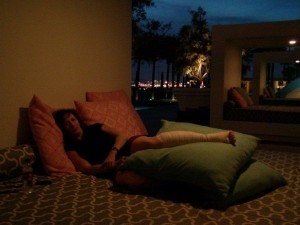
After leaving the hospital, Kelly and I went out for lunch as I am always hungry post-anesthesia recovery with all of my surgeries. I have never had nausea or grogginess after any surgery. I really do become like an energizer bunny and I certainly do not get sleepy with pain medication either. However, I do take a lot of natural supplements as soon as I get my hands on my suitcase full of them in recovery. Here is a photo of me laying around in an outside cabana at the hotel in the evening of the day of surgery. The next day Kelly and I took a taxi to Vegas and she pushed me in a wheel chair all over The Grand Canal Shoppes connected with the Venetician Hotel of Vegas. http://www.thegrandcanalshoppes.com/
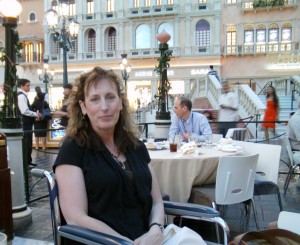
When in a store that I liked, I could stand up and walk a little then sit back down in wheelchair. The main thing was to keep my leg elevated and ice behind my knee to keep swelling down. Kelly and I had such a wonderful week in Henderson/Vegas. Perfect weather in May. It was a special trip to remember and a mental relief for me to finally have a surgery that could take away nerve pain. Kelly, a special friend that lives on my same hill in rural Idaho, enjoyed the fine dining and benefits of the suburbs that we miss where we live in Idaho. She is originally from California and I am from Ohio.
Here is a video of Dr. Tollestrup checking my leg 2 days after the surgery before we were to fly home the next morning.
He would normally re-check a leg at 7 days after a surgery for an in-town patient. However, since I didn’t know if I would ever see the doctor again due to traveling expenses, I appreciated that he took the bandage off so I could see what my leg looked like before getting on an airplane the next morning.
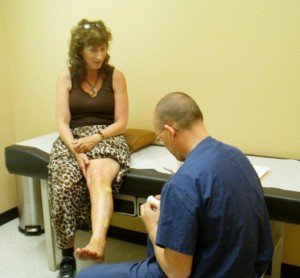
He was very kind to accommodate me and to ease my apprehension as to what to expect post-surgically. My follow up care and stitches were taken out by my primary care doctor back in Spokane, WA. Per Dr. Tollestrup’s request, we stayed in touch by email and I sent him photos of the surgical sites on my leg for his review too. With wheelchair service at the airports and then crutches when I got home for about a week to ease into walking greater distance, I was doing very well. I was off pain medication once I got home traveling from Vegas back to Idaho.
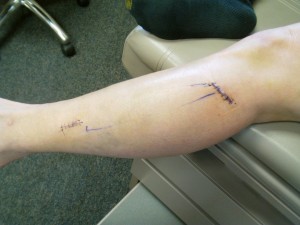
The healing process was uneventful and no big deal. Post surgery recovery was easier than my prior ankle arthroscopy surgery. I kept the ace wrap bandage on my leg after the stitches were out mainly for comfort, support to the leg muscles and compression against swelling for about 4 weeks. Even though there were only two tiny incisions, surgical work was done down my entire leg underneath the skin -anterior/lateral fasciotomies to decompress tight fascia making sure the nerve was completely freed up. These fasciotomies also helped me with non-traumatic compartment syndrome that I had experienced before the surgery. After the ace wrap, I regularly wore a pair of black sport compression running knee high socks. I was gradually back on my horse to start riding after 4 weeks of healing.
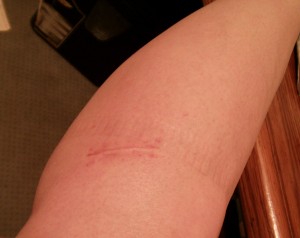
After about 3 months, I would use the compression socks on occasion especially when I was sitting a lot at my desk. I look back now and say that at 3 months post-surgery, the majority of my healing was well established and I liked the results.
With such successful results, I planned another trip back to Henderson for the second of the two nerve surgeries. Because I had eliminated pain on part of my leg with the first surgery, the rest of the nerve pain this time more precisely in top of foot near big toe and back of calf was now speaking up. This next time around was for the following preoperative diagnosis:
1. Idiopathic neuropathy, 2. Compression neuropathy of left proximal tibial nerve at the level of the soleus sling, 3. Compression neuropathy of deep peroneal nerve, dorsum of foot, 4. Nontraumatic compartment syndrome, posterior and deep compartment, lower leg.
So on 9/25/12 I was at the Horizon Surgical Center, Henderson for round 2 in peripheral nerve surgery. This time around my husband was able to travel with me, and he thoroughly enjoyed the Green Valley Ranch Resort and their service was top-notch just like it was in May.
Dr. Tollestrup visited my husband after the surgery and said the surgery went very well. He did say that I had significant compressions of my deep peroneal and proximal tibial nerves and that I should be feeling better in my lower extremity when I heal from the surgery. Attached here are my surgical reports 9-25-12 Nerve Surgery pg 1 and 9-25-12 Nerve Surgery pg 2 and 9-25-12 Nerve Surgery pg 3
When I awoke from this surgery, I was keenly aware of severe spasms in my left leg from my knee to my left Sacroiliac (SI) joint. I felt no pain from my knee to my foot where the surgery was actually performed. It wasn’t until a week later when I read my surgical report that I discovered a possible cause to the severe upper left leg spasms. While under anesthesia, my lower left extremity was in a frog leg position to make it possible to do the proximal tibial nerve decompression incision. This surgical position stressed my underlying SI joint dysfunction and increased my normal SI joint pain dramatically. I had absolutely no complications from the anesthesia and I awoke as I normally do. However, no one can predict when a surgical position will play havoc on the rest of your body while under anesthesia and this was one of those times. Needless to say, at that moment, I felt frustrated, angry and scared that the Demerol shot they gave me in recovery only worked a little and the post-discharge Hydrocodone pain pills did not work back at the hotel.
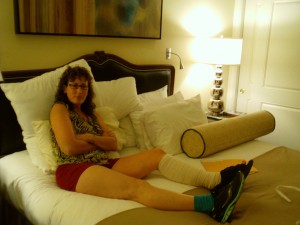
Since I could not reach my surgeon that night for a prescription change, the Walgreen’s pharmacist suggested going to the emergency room. I did not have to wait long as they took me in ahead of others waiting. I was then prescribed Diazepam by the ER doctor which did work a miracle for the spasm-type pain. I never needed the pain pills as Diazepam was the only medication I used during the next week after the surgery.
After this surgery, my husband and I flew to Ohio for our nephew’s wedding. The wheelchair service with Delta Airlines was excellent and my sister was waiting in Ohio to pick me up with a wheelchair. I had a wonderful time with family and friends. I had no problems with my leg and this time around I could walk farther sooner because my shin didn’t ache as much like the last nerve surgery. I was very pleased from the beginning of recovery how much better my foot felt. The localized nerve spasms, coldness, tingling were gone.
I spent the week there in Ohio driving two round-trips of 6 hours each from eastern suburbs of Cleveland to Toledo working also on second opinions regarding my SI Dysfunction. I had prior arranged appointments with the Prof/Chairmen of dept. of Orthopedics at the Univerisity of Toledo – Dr. Nabil Ebraheim and with Dr. Kellis of Precision Orthopedics, Chardon, OH Prior to this 2nd nerve surgery, I had been researching all summer long on lumbar and SI issues. I was already formulating a plan to get to Gainesville, GA to see the Team of SI Joint Experts.(See my SI-Instability/Surgery Story)
Prior to an SI surgery, an SI joint diagnostic/therapeutic injection should be done as a pre-surgical workup. Well sometimes we certainly don’t know the reason why we go through something like I did with the post-op nerve surgery SI pain; but in the end of the day, God’s timing was perfect. It is my opinion that He allowed this to happen so I could experience the timely SI Injection given to me by Dr. Ryan Szepiela, at ProMedica Wildwood in Toledo, Ohio. Without the post-op increased pain, I probably would not have had the injection done at that time and the course of history may have been altered to this day. This injection brought me immediate and definitive pain relief for which I was grateful. It also was a positive pre-surgical left SI diagnosis confirmation. Date 10-5-2012 for injection – see my Chronological page for those results.
So after 2 weeks of the fast paced medical vacation between Idaho-Vegas-Cleveland-Idaho, I arrived home in time for my 2-week post-surgical checkup. I did have quite a bit of bruising near base of toes and around lateral ankle not necessarily visible in photos. Here are my 2-week post-op photos showing the incisions for this second surgery:
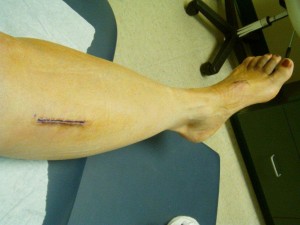
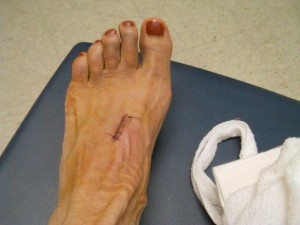
I continued with the ace wrap for 4 weeks to support my foot. There were some sensations different than the first nerve surgery. Because a Tenotomy of the extensor hallucis brevis tendon was needed to expose the deep peroneal nerve underneath, I did have some tendon pain near base of my 2nd and 3rd toes which is now completely resolved. I was back to riding my horse after 6 weeks this time because the medial side of my leg had the proximal incision inside my riding boot against the side of the saddle. Also my ankle/foot needed a little more time to heal.
The recovery from this surgery was not without heartache. Most of the time, I was extremely pleased and at other times I waged a war of doubt in my mind. The SI Dysfunction continued to increase and nerve symptoms going down my legs remained at a steady level. I was having a hard time discerning between the benefits of the local leg nerve decompressions versus the left leg sciatica nerve pain. I was in horrible pain while performing and standing an hour in our local Christmas Contada both with my SI joints and localized post-op ankle pain. See my Pro-active faith blog.
By Jan. 8th 2013 when I saw Dr. Khalid Shirzad, my foot and ankle Specialist of Northwest Orthopedics in Spokane for a 15 week follow-up on this nerve surgery, he concurred that I had healed very well. He acknowledged the satisfaction and nerve pain reduction I had with this 2nd nerve surgery performed by Dr. Tollestrup in Henderson, NV. He noted some ankle pain (not nerve pain) that he would further discuss with me after I recovered from my then planned trip to Gainesville, GA for the 1-17-13 SI Fixation Surgery. It felt good to know prior to going off for the SI surgery that my nerve surgeries were now behind me. I’m scheduled to see Dr. Shirzad on 4/18/2013 for a follow-up on the ankle.
As I close this chapter of my personal medical journey regarding peripheral nerve surgery, may I reiterate again that I highly recommend Dr. Timothy Tollestrup at Neuropax Clinic located at 3035 West Horizon Ridge Parkway, Suite 120, Henderson, NV 89052 phone 702-666-0463 for all peripheral nerve surgeries whether it be for lower or upper extremities. Here is his website: https://nevadanervesurgery.org All the nurses involved in my surgeries reassured me and spoke so highly of his surgical skill. His 2 surgical interventions reduced 100% of my localized lower left leg nerve pain and overall leg pain by at least 70%.
THANK YOU DR. TOLLESTRUP AND GOD BLESS YOU FOR PLAYING A SIGNIFICANT ROLE IN MY MEDICAL JOURNEY!
The other 30% of residual pain at this moment is due to chronic Proximal Tibiofibular Joint instability/subluxation and distal fibula/ankle issues along with intermittent sciatica pain coming from my piriformis syndrome (see my Diagnosis page of this website). I am still in the process of conservative care for these on-going issues which do have a direct and indirect connection with the former SI Joint Dysfunction. All for now, with future blogs to be written as the journey continues!
